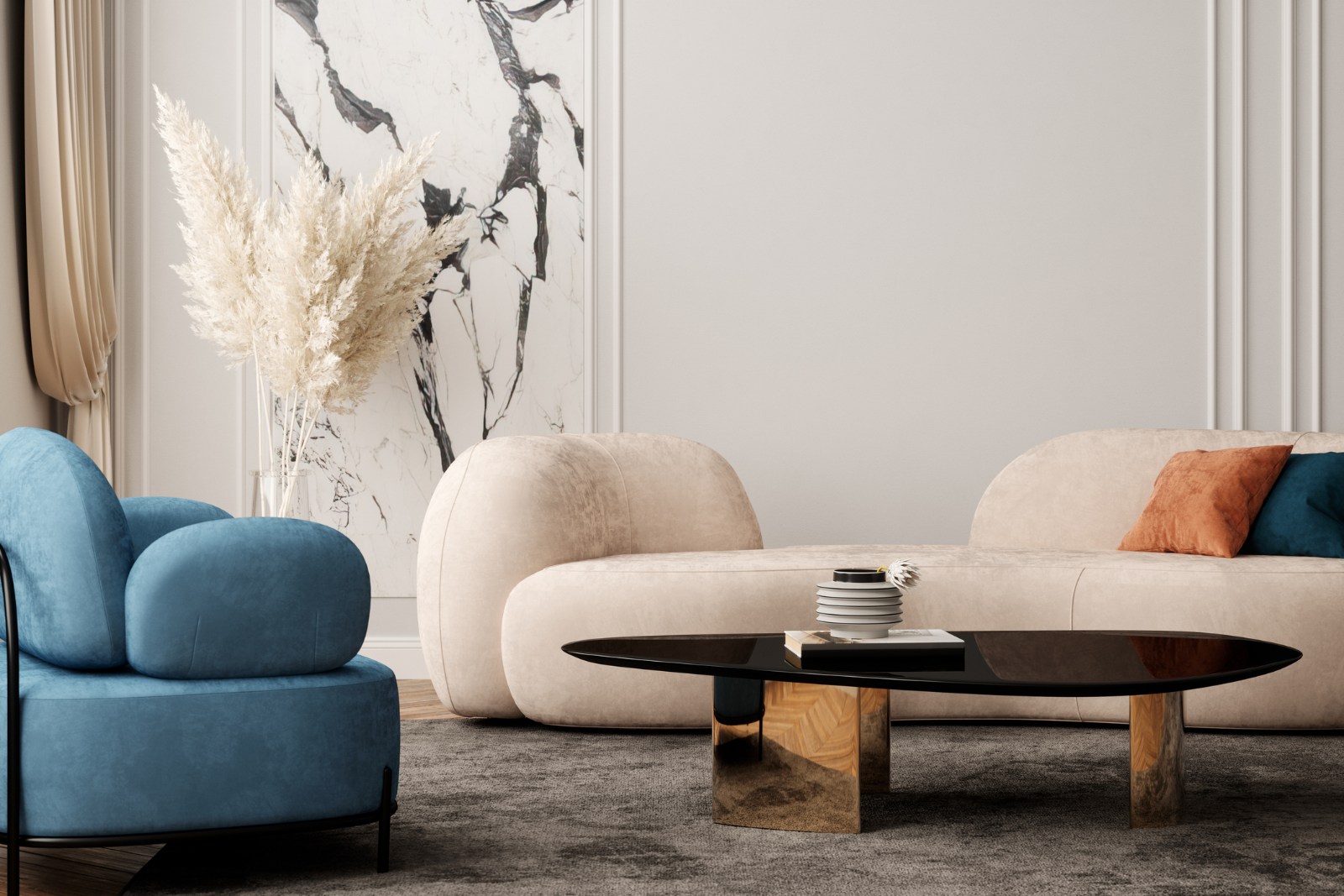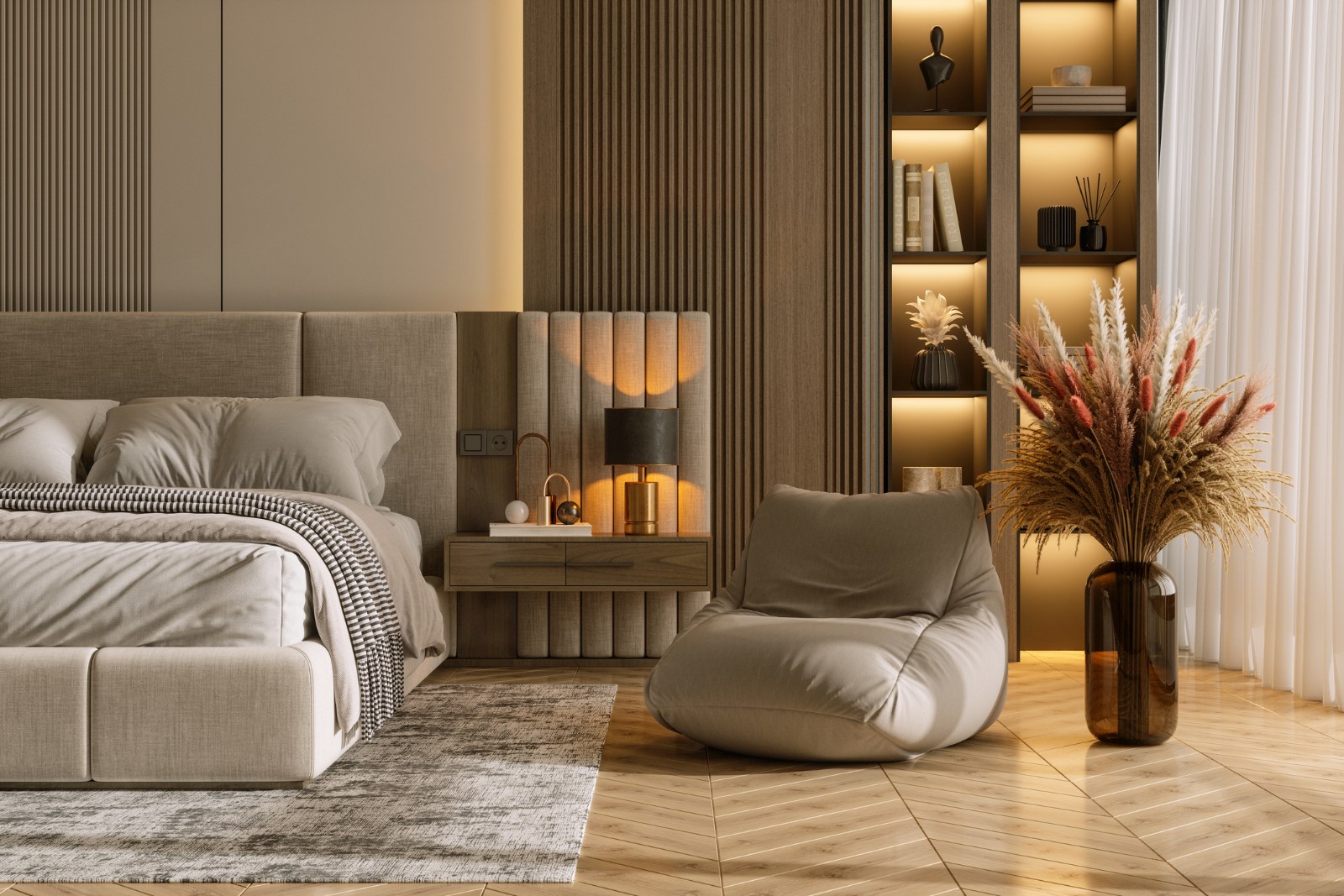Why texture is the new luxury in home design

Luxury is now defined by depth and feel.
Texture is rewriting the rules of luxury design. Designers have traded shine for substance by creating a new language of luxury rooted not in what dazzles the eye, but in what soothes the soul. Texture has become the ultimate status symbol—and once you understand why, you’ll never look at a room the same way again.
Table of Contents:
What Does Texture Mean in Interior and Architectural Design?

Texture is how a space feels to the eye and to the touch.
When people talk about luxury in home design today, they’re not just talking about price tags or rare materials. They’re talking about texture. And while “texture” might conjure images of throw pillows or a nubby boucle chair, it’s actually a far richer, more layered design concept.
Texture is where sight meets touch, where the brain remembers the feeling of a surface even before your fingers make contact. It’s one of the reasons a room feels warm, cool, cozy, elegant, or elevated.
Physical texture vs. visual texture
Texture is defined as the surface quality of a material and it appears in two ways: physical texture and visual texture.
Physical texture is the literal feeling beneath your fingertips—the velvety nap of a sofa, the grain of oak cabinetry, the ridges of natural stone, the softness of wool, the cool smoothness of marble. These textures have relief: peaks and valleys that catch light, cast shadows, and give a surface its distinct personality. Designers lean on physical texture because it instantly communicates warmth, comfort, and mood.
Visual texture, on the hand, is the idea that a surface can look textured even if it’s perfectly smooth. Think of fine patterns, grain-like finishes, woven motifs, faux brick, cloudy plaster, veined marble, or even the shadow play from architectural lighting or rattan pendants. Your eyes read these surfaces the way your hands read tactile ones.
Visual texture expands what’s possible. Smooth walls can be made to look like silk. A matte tile can appear weathered. The right pattern can mimic stone or create the illusion of depth. Small, repeated motifs can also feel like texture from across the room.
Using contrast to create dimension
The real magic happens when physical and visual texture meet—and especially when they contrast. Some of the most effective types of contrast are:
- Smooth vs. rough
- Matte vs. glossy
- Hard vs. soft
- Reflective vs. grainy
This push-and-pull gives a room dimension. Pair polished marble with raw wood, linen with lacquer, a silky rug under structured furniture, or matte walls beside glossy accents. These combinations create tension in the best way because it’s the kind that elevates a space from “pretty” to “wow, this feels incredible.”
Examples of texture in design
If texture is the new language of luxury, then the materials you choose are the alphabet. From the soft pull of natural fibers to the sculptural depth of artisan wall finishes, these are some of the most effective (and beautiful) ways designers bring texture to life:
- Natural textures: Linen, rattan, travertine
Nature has always been the world’s greatest texture artist. Materials like linen, rattan, and travertine bring that organic richness into the home in a way that feels effortless and timeless.
Linen carries that slightly rumpled, breathable quality that instantly softens a room. It’s tactile without being heavy and it has a visual texture that makes even a simple pillow look elevated. Rattan, on the other hand, is both tactile and visual. The woven construction, which creates shadows and depth, is the kind of material your eye wants to follow and your hands want to touch.
Then there’s travertine, a stone defined by its natural pits, striations, and tonal variations. It’s smooth yet irregular, matte yet visually complex, often appearing cooler and more grounded than a high-polish stone.
- Refined contrasts: Polished marble and brushed metal
Luxury design thrives on contrast. Polished marble brings smoothness, reflectivity, and an almost liquid shine. Next to it, brushed metal introduces softness in the form of micro-ridges that catch the light differently. One surface gleams; the other glows. One is cool and sleek; the other is textured and warm. Together, they elevate each other and create a harmonious balance that invites both visual and tactile engagement.
- Architectural surfaces: Venetian plaster, microcement, hand-troweled walls
The most luxurious textures nowadays often come from wall finishes rather than décor. Materials like Venetian plaster, microcement, and hand-troweled treatments introduce a soft, sculptural texture that transforms a room from the ground up.
Venetian plaster is visually rich. Its subtle movement, tonal variation, and soft sheen mimic the look of silk or stone depending on how the light hits it. Even though the surface can be smooth to the touch, the visual depth is unmistakable. Microcement offers a matte, seamless look that feels contemporary yet grounded. Hand-troweled walls take this even further. Each stroke becomes part of the story, creating peaks and valleys that enhance shadow play.
WHY IS TEXTURE REPLACING SHINE AS THE HALLMARK OF LUXURY?

Not everything that glimmers is luxury anymore—texture tells the real story.
For decades, luxury interiors meant gleam—polished marble, glossy finishes, and metallic accents. But recently, designers stopped chasing reflection and started chasing feeling. Texture has become the new symbol of modern luxury, marking not just an aesthetic shift but a sensory one.
A post-pandemic shift toward comfort, authenticity, and wellness
The pandemic transformed homes from beautiful backdrops into spaces supporting full lives, which includes work, rest, family, and creativity. This sparked demand for environments that feel soothing, organic, and emotionally supportive.
Texture delivers exactly that.
Where shine feels cold and untouchably perfect, textured surfaces such as linen, wood grain, plaster, boucle, and clay feel alive. They carry natural imperfections, invite touch, soften acoustics, and give the eye places to rest.
The rise of quiet luxury and sensory minimalism
We’ve entered an era of what many are calling quiet luxury—a move away from big logos, flashy statements, and ornate finishes in favor of subtlety, craftsmanship, and materials that whisper rather than shout. In design, this shows up as sensory minimalism, where the focus is on calming textures, depth, and emotional resonance instead of decorative excess.
Texture is at the heart of this movement. Venetian plaster, hand-troweled walls, raked wood, and softly veined stone feel sophisticated before they even look it. While glossy surfaces bounce light back at you, it’s the textured ones that hold it.
The psychology of texture
Texture doesn’t just affect how a room looks—it affects how a room feels. It engages our senses of touch, sight, sound, and even emotion. When designers call texture a “sensory experience,” they mean it literally. Textured spaces can influence how we feel comfort, safety, and calm. Here’s why it matters:
- Texture feels more human than flat finishes. Organic surfaces like stone, clay, earth, and woven fibers mimic nature’s irregularities. Because of that, our brains instinctively read them as warm, grounding, and approachable.
- We react emotionally to how materials look like they will feel. A fluffy rug seems “warm” before you touch it; a metal panel “feels cold” even at room temperature. With this built-in sensory expectation, texture bridges memory and imagination by letting touch influence sight.
- Organic texture provides emotional grounding. Imperfect, nature-inspired finishes help people feel connected to their environment. This is why biophilic, Wabi-Sabi, and Japandi interiors rely heavily on textured surfaces.
HOW DESIGNERS ARE USING TEXTURE TO DEFINE LUXURY

High-end design is all about the layers.
From sculpted walls to woven accents, designers are using specific strategies to make spaces feel rich, grounded, and alive. Here’s what that looks like in action.
The art of layering
Layering is about mixing tactile and visual experiences in a way that feels natural, cohesive, and deeply sensory. The most sophisticated interiors are rarely built from a single material or finish. Instead, they come alive through contrast, variation, and rhythm.
- Tactile layers: Velvet, suede, linen, and wood grain
Tactile layering is the foundation. It’s what makes a room not just beautiful but touchable. Soft and structured textures play off one another by creating warmth, comfort, and depth.
Velvet adds softness and a light-catching sheen while suede offers a matte, cozy warmth. Linen, on the other hand, brings an airy, natural feel that keeps a space relaxed. And wood grain—whether smooth, knotted, or textured—adds natural variation that softens modern architecture.
Designers like Studio Shamshiri excel at these tactile pairings. Their spaces often unite earthy woods, handwoven textiles, and natural stone in a way that feels both modern and timeless.
- Visual layers: Shadow, reflection, matte vs. gloss
If tactile layers appeal to the hands, then visual layers appeal to the eyes. Shadows from ribbed cabinetry or sculptural lighting create rhythm while reflections from polished metal or glossy stone add brightness and contrast. Mixing matte and glossy finishes is especially effective since matte absorbs light for a calm look while gloss reflects it for energy.
No one layers visual texture like Kelly Wearstler. Her compositions often include a dance of light across stone, metal, ceramic, and plaster, with everything glowing at a different frequency.
- Architectural texture: Ribbed stone, fluted wood, sculpted plaster
Architectural texture adds a sculptural element that grounds the whole design of the home. Ribbed stone creates movement, fluted wood softens walls with gentle lines, and sculpted plaster adds a subtle three-dimensional backdrop.
These textures shape not just what a room looks like, but how it feels to move through it—from how light moves across the surfaces, how shadows shift, and how the space seems to come alive.
Using light to bring texture to life
Texture comes to life through light. You can layer the richest materials but without the right lighting, their depth stays hidden.
Texture interacts with light differently depending on the material. Smooth, glossy surfaces bounce light back, creating highlights. Matte or irregular textures absorb and scatter it, softening the glow. Ribbed, carved, or woven finishes cast tiny shadows that shift throughout the day.
- Wall grazing
Wall grazing is one of the most powerful lighting techniques for enhancing texture. It involves placing light close to a vertical surface so it rakes across the material rather than shining at it head-on. Suddenly, every ridge, ripple, and brushstroke becomes visible.
- Accent lighting
Accent lights like picture lights, directional spotlights, or adjustable sconces are perfect for creating texture “moments” throughout the home. For example, a spotlight over a textured ceramic vase brings out its ridges and glaze variations while a picture light above a woven art piece highlights its fibers and craftsmanship.
- Warm and cool lighting
Color temperature has a noticeable effect on how texture reads. Warm lighting enhances softness, making materials like suede, linen, and warm woods feel cozy and inviting. Cooler lighting, on the other hand, sharpens details and makes stone, metal, and concrete appear cleaner and more architectural.
- Layered lighting
Just like how materials benefit from layering, so does lighting. A combination of ambient, task, and accent lighting creates dimension that no single light source can achieve.
Material matters
When it comes to creating texture-driven interiors for a home, the materials you choose matter just as much as how you layer them.
Natural materials are one of the best ways to add texture because they already have variation, grain, knots, and subtle imperfections that make them feel alive. These materials include:
- Travertine: For their soft, earthy presence with its natural pores and tonal variation.
- Limestone: A chalkier, more understated texture with a matte finish.
- Walnut: Brings warmth and richness through its deep grain and natural luster.
- Cane: Introduces a woven, airy texture that lightens a space and creates subtle shadow play.
- Bouclé: Adds cozy dimension through its looped yarns.
- Silk: A refined, delicate sheen that catches light gracefully
- Clay plaster: Ties it all together with its velvety matte finish and gently undulating surface.
Sustainable finishes also carry just as much weight in good home design. Textured materials fit naturally into this approach because many are handmade or sourced from natural materials. Recycled woods, for example, bring warmth and history through patina, knots, and grain patterns that have aged gracefully.
Low-VOC paints create healthier environments while offering rich, velvety finishes that feel more atmospheric than traditional paint. And handmade ceramics have slight variations in glaze, shape, and surface that make each piece feel unique and human.
FAQS
What defines texture in home design?
Texture is the surface quality of a material, both in how it looks and how it feels. It includes physical texture (velvet, stone, wood grain, bouclé) and visual texture (matte finishes, patterns, shadow play, plaster movement). Texture adds depth, dimension, and sensory interest that make a room feel more engaging and complete.
Why is texture important in luxury interiors?
Texture makes luxury feel warm and lived-in, not flashy. It adds depth, comfort, and a sense of craftsmanship through materials like plaster, stone, and natural fibers. Modern luxury values subtle and sensory richness, which is something texture delivers better than shine or ornamentation.
What are the best materials for adding texture?
Some of the most effective texture-rich materials include travertine, limestone, walnut, cane, bouclé, silk, and clay plaster. Sustainable options like recycled woods, low-VOC paints, and handmade ceramics also add great variation. Architectural textures like fluted wood, ribbed stone, and plaster walls bring sculptural dimension to a space as well.
Can texture replace color in design?
Yes. In many luxury home interiors, texture takes the lead while color stays neutral. Layered fabrics, stone, plaster, wood, and matte–gloss contrast can create depth and character without relying on bold hues. Texture also keeps minimalist palettes from feeling flat.
How do lighting and texture work together?
Lighting brings texture to life through shadows and highlights. Grazing lights accentuate plaster and stone, accent lights draw attention to woven or sculptural pieces, and the temperature of your bulbs—warm or cool—affects how soft or sharp textures appear. Done right, lighting makes texture feel dynamic and alive.
THE FUTURE OF LUXURY IS FELT, NOT SEEN
As homes continue to evolve into sanctuaries rather than showpieces, the most coveted spaces will be those that engage all the senses. At the end of the day, luxury isn’t just about location or square footage. It’s about how a space makes you feel.
Ready to create a luxury home in Beverly Hills that reflects how you want to live? There’s no Realtor who knows the market better. With my expertise in Beverly Hills luxury real estate and finely tuned eye for design, I can help you find a home that feels as extraordinary as it looks.
Give me a call today at 310.291.6646 or send me an email to get started.

Browse our latest news and updates below

![[ai_client_name]](https://joycerey.com/app/themes/joycereycom_2024/assets/images/site-logo-white.svg)
